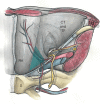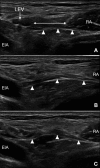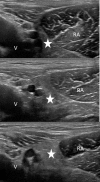Imaging of inguinal-related groin pain in athletes
- PMID: 29947268
- PMCID: PMC6319843
- DOI: 10.1259/bjr.20170856
Imaging of inguinal-related groin pain in athletes
Abstract
Inguinal canal-related groin pain is common in athletes and may involve numerous structures such as the conjoint tendon and the transversalis fascia. Ultrasound is the only dynamic tool that shows the passage of preperitoneal fat at the level of the Hesselbach triangle and allows excluding true inguinal hernias. Fascia transversalis bulging and inguinal ring dilatation may also be described. MRI assesses injuries of rectus abdominis and adductor longus enthesis and osteitis symphysis but its accuracy for the diagnosis of inguinal-related groin pain remains debated.
Figures








Similar articles
-
Ultrasound of the athletic groin.Semin Musculoskelet Radiol. 2013 Feb;17(1):34-42. doi: 10.1055/s-0033-1333912. Epub 2013 Mar 13. Semin Musculoskelet Radiol. 2013. PMID: 23487332 Review.
-
Inguinal Hernia in Athletes: Role of Dynamic Ultrasound.Sports Health. 2017 Sep/Oct;9(5):414-421. doi: 10.1177/1941738117717009. Epub 2017 Jul 21. Sports Health. 2017. PMID: 28732177 Free PMC article.
-
Sports Hernia: Definition, Evaluation, and Treatment.JBJS Rev. 2017 Sep;5(9):e6. doi: 10.2106/JBJS.RVW.17.00022. JBJS Rev. 2017. PMID: 28937419 Review. No abstract available.
-
Imaging Athletic Groin Pain.Radiol Clin North Am. 2016 Sep;54(5):865-73. doi: 10.1016/j.rcl.2016.04.007. Radiol Clin North Am. 2016. PMID: 27545425 Review.
-
Groin pain beyond the hip: how anatomy predisposes to injury as visualized by musculoskeletal ultrasound and MRI.AJR Am J Roentgenol. 2011 Nov;197(5):1190-7. doi: 10.2214/AJR.10.4890. AJR Am J Roentgenol. 2011. PMID: 22021514 Review.
Cited by
-
Henle's Ligament: A Comprehensive Review of Its Anatomy and Terminology over Almost One and a Half Centuries.Cureus. 2018 Sep 26;10(9):e3366. doi: 10.7759/cureus.3366. Cureus. 2018. PMID: 30510876 Free PMC article. Review.
-
Optimizing Conservative Management of Groin Pain in Athletes: Insights from a Narrative Review.Life (Basel). 2025 Mar 6;15(3):411. doi: 10.3390/life15030411. Life (Basel). 2025. PMID: 40141755 Free PMC article. Review.
-
Long-standing groin pain in contact sports: a prospective case-control and MRI study.BMJ Open Sport Exerc Med. 2019 Mar 19;5(1):e000507. doi: 10.1136/bmjsem-2018-000507. eCollection 2019. BMJ Open Sport Exerc Med. 2019. PMID: 31191965 Free PMC article.
-
What the Radiologist Needs to Know About Sport Hernias: A Systematic Review of the Current Literature.Diagnostics (Basel). 2025 Mar 20;15(6):785. doi: 10.3390/diagnostics15060785. Diagnostics (Basel). 2025. PMID: 40150127 Free PMC article. Review.
-
Anatomical Features in Inguinal-Pubic-Adductor Area That May Contribute to Gender Difference in Susceptibility to Groin Pain Syndrome.J Pers Med. 2024 Aug 14;14(8):860. doi: 10.3390/jpm14080860. J Pers Med. 2024. PMID: 39202051 Free PMC article. Review.
References
Publication types
MeSH terms
LinkOut - more resources
Full Text Sources
Other Literature Sources
Medical

